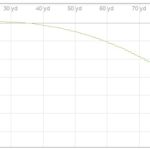For those of us who have been around firearms and airguns for a long time and who grew up before video games, the idea of bullet drop, drag coefficient, trajectory, and ballistics is part of the normal thought process when taking a shot. But there are many folks new to the sport who don’t understand the basic principles that help you put your shot on target. Ballistics and Trajectory are very weighty subjects that certainly need more than a few hundred words to explain, but we are going to try our best to give you at least some of the basics so you can start to be more successful in the field. Let’s get started.
The “flat” Trajectory for Kill Zone Optimization
Since we are focusing on airguns, most with a usable max effective range of 100 yards, we will leave out the discussion about the curvature and rotational speed of the earth with regard to shot placement. Rather, we will focus on drag and gravity.
For this discussion, we’ve chosen the JSB 18.13 .22 caliber pellet and used the commonly accepted ballistic coefficient (BC) of .035 for our calculation. In simple terms, you can consider the ballistic coefficient as a measure of how well a projectile can resist air resistance while moving to the target. Because of its shape, a pellet has a lot of resistance and, therefore, has a very low (poor) BC. While the drag caused by the pellet’s skirt helps maintain stability and accuracy, it also causes it to slow down far more quickly than an airgun slug. Let us know if you would like a follow-up article on Airgun Slug Ballistics and Trajectory.
Let’s assume that our airgun is optimally set for hunting, creating a flat trajectory that keeps the pellet in the hunting “sweet spot” for as long as possible. For reference, we’ve created this chart on ShootersCalculator.com: https://shooterscalculator.com/ballistic-trajectory-chart.php?t=36ec3ebe.
Using our pellet’s weight of 18.13 grain, an initial muzzle velocity of 900 FPS, and a scope height of 1.5” above the bore, we can see that the pellet starts on a slightly upward path until it reaches its first zero point of 14 yards. As it transects that first zero point, it continues to rise until it peaks at .49” above the sight line at around 30 yards and begins to fall with a second zero point of about 40 yards. So from about 10 yards to 45 yards, the pellet will be within .5” of the sightline. Theoretically, you could aim at anything from 10 to 45 yards, and provided your aim was true, you’d be in a 1” kill zone on small game.
After the Kill Zone(s)
After the 2nd zero point, our pellet begins to lose velocity and drop rapidly. The chart demonstrates this by showing energy and velocity at various ranges. At 50 yards, our pellet has lost 9 FPE of energy, and at 100 yards, that’s further reduced to just 15 FPE, less than half of its starting point of 33 FPE. Additionally, you can see that at 50 yards, we only have a drop of about .87”, but by 100 yards, we have a 16.36” drop. Essentially, our pellet just fell off a cliff.
What if we change our zero? Will that help?
Here is a 2nd chart, having moved our zero point to 50 yards. A lot of airgunners sight in at 50 yards only to find that their shot trajectory is very difficult to manage when hunting at various ranges. Let’s take a look at how this works out. https://shooterscalculator.com/ballistic-trajectory-chart.php?t=fc494332
As you review this chart, notice that our initial zero is now at about 11 yards, with a 2nd zero at 50. There’s a more pronounced curve with the high point at around 30 yards a full inch over the sight line. If you were trying to hunt small game with a kill zone of about 1 inch, you would need to hold under your target at various ranges to adjust for the shot trajectory. If you’ve ever found yourself missing close-in shots, this could be why. Finding an optional zero is key. We have an article on this for reference.
Our holdover is certainly less pronounced at 100 yards. However, the variances in the shot trajectory are more complicated and harder to manage unless you are always shooting at a fixed distance.
That’s a lot of MATH!
If you are bench shooting at a fixed distance, then zeroing at that fixed distance is not a problem. Suppose you plan to shoot objects at varying distances, and accuracy is critical. In that case, you’ll need to put in some trigger time to find the optimal zero and learn your pellet’s trajectory and impact point at various ranges.
We’ve just scratched the surface of how this works. Hopefully, you can see that your pellet’s trajectory will vary based on its ballistic coefficient, velocity, and zero point and you will be able to take this knowledge into the field and be more consistently accurate with your airgun.
